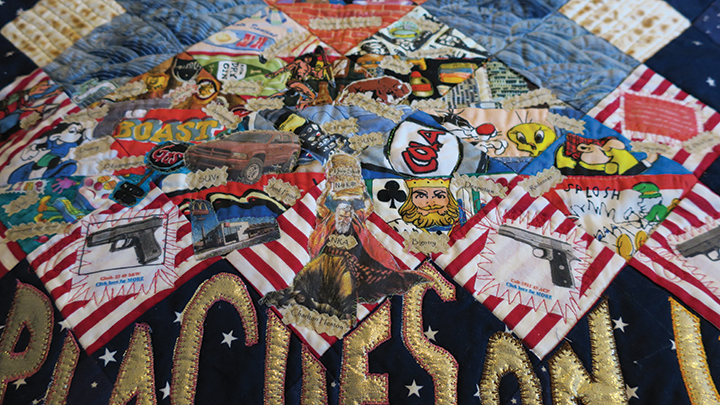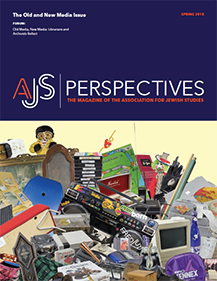
Two days later, Heston—still clad in his Moses garb—was staring up at me from the colorful quilted folds of a matzah cover. How did this come to pass?
A matzah cover mediates on multiple levels. Its basic function is to hold three (or more) pieces of unleavened bread. It has no ritual specifications—a napkin would do. It may contain lettering, images, phrases, colors, textures. It mediates as a ritual object, one that shelters one of the holiday’s core symbolic foodstuffs until the appropriate moment in the Passover seder. It may also convey information about a family, standing in for history if it is an heirloom, about wealth if it is made of sumptuous fabrics, or about Passovers past if it is spotted with red wine stains.
Or, it may mediate in even more intentional ways. It may narrate or tell a story about its creator’s vantage point on the universe. Such was the case with the cover on which I spied Charlton Heston. I found it in a large pile of quilted objects at the home of Cathy Perlmutter, thenpresident of the Pomegranate Guild of Judaic Needlework and an avid craft blogger. Among dozens of other objects, Cathy showed me a plethora of matzah covers. There was a Pokémon-themed matzah cover from the year one of her children was engrossed in that world. Another featured a carefully, ornately illustrated leaf of lettuce. Others featured trompe l’oeil fabric that resembled the beige grains of a sheet of matzah itself.
Then there was a matzah cover she calls “Old Plagues on Them, New Plagues on Us.” The old plagues were predictable, drawn from the book of Exodus narrative: blood, locusts, etc. But the new plagues—they were something else. According to Cathy, they were what she considered to be modern plagues in 2001, when she made the piece, including, but not limited to: “handguns, pollution, narcissism, steroids . . . endangered species (they themselves aren’t plagues, but the whole endangerment thing I courageously oppose), despotism, bigotry (under a kingly figure who foreshadows 2016 political candidates?), soda, and, um, cell phones? I can’t recall what I had against cell phones, which were new at the time.” I learned some of this from Cathy herself in person. However, I found this precise quote not in my interview transcript, but rather, by going to her blog, Gefilte Quilt. You can, too. Fabric objects mediate, and our knowledge of them is transmitted on multiple levels.
Charlton Heston is still haunting me, many months later—this time, on the glass screen of my office computer. Bearded, clad in his flowing red and brown robes, he towers against a background of red and white stripes, juxtaposed with bright cartoon characters holding guns, as well as a bison (“endangered species”) and the enormous head of a cartoon king from a deck of cards (“despotism”). He holds one tablet of the law high above his head. A badge reading “NRA” has been carefully stitched across the center of his chest. On the tablet itself, Cathy sewed a tag with another sentence: “Thou shalt not kill.” In this collage of fabric and language, she performs a midrash on multiple levels. The imperative of the commandment is reinscribed upon a reduplicated celluloid image, this time in cloth. Rendered in the spring of 2001, it calls to me here in 2018.
Media are instruments by which we transmit affect, memory, traditions, experiences: they are the way we make the world knowable. That knowability accrues different emotions in varied contexts. The many meanings of Charlton Heston depend on their medium. The biblical epic I watched in my hotel room was intended to provoke a very different sensation from the image of the same man, in the same costume, appliqued onto Cathy’s matzah cover. Both wore the same clothing. One was supposed to inspire fear and trembling and a kind of celluloid awe; the other was meant to frighten us through his association with the NRA and a means of killing—a chilling resonance that, for me personally, has only grown over the years, and which stands out like a wound here in the weeks after the massacre at Marjory Stoneman Douglas high school. Those guns accompanied by blood red stitching, that man with his NRA badge: these modern plagues have come for the first born in an endless repetition of shootings that perhaps not Cathy, not any of us, could have imagined when she stitched the piece seventeen years ago. One production, the film, attempts to command with its grandiose vision; the other, the fabric piece, inserts a critique from a place of intimate smallness. The Heston/Moses of The Ten Commandments is a visual and auditory production; the Heston of the matzah cover is both visual and tactile. What would it mean to get matzah crumbs and wine on Charlton Heston? What would De Mille think? The larger-than-life celluloid presence has been quite literally shrunk down to a tiny scale and subjected to the ordering logic of the seder meal.
I linger here, in a space formed by pixels and cloth, material and ritual technologies, because it places us so precisely at the intersections of old and new media and reveals their continuity. There are antique media here—stone tablets, modern mass media—film, and contemporary digital media—blogs. There are cloth media—which are simultaneously as old as primeval needles and as new as electrical sewing machines. All of these intricate mediations are gathered together in the long-standing Passover tradition of ethical critique and calls for justice. I am particularly struck by how the solid, rough stone tablet is rendered in soft, malleable cloth: a juxtaposition that I want to read playfully as a transformation, a transubstantiation, even a sort of alchemy. As scholars of Jewish Studies, we must listen, look, and feel carefully for processes of mediation on multiple levels, and the work that mediation does in the world. For my contemporary interlocutors, crafting Judaism is a means of mediating the world around them, riffing on traditions in irreverent and poignant ways.

